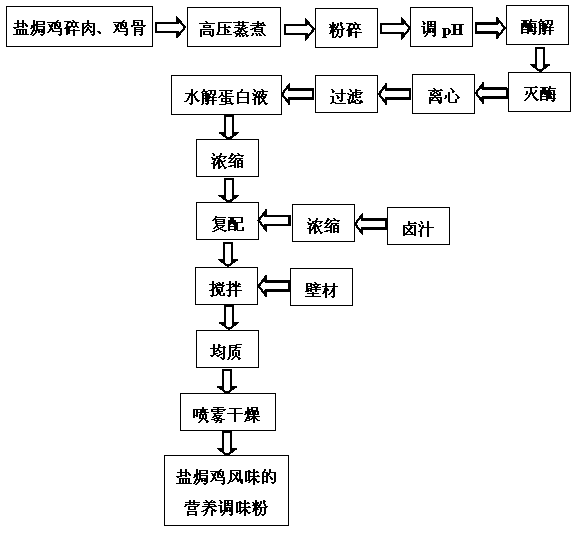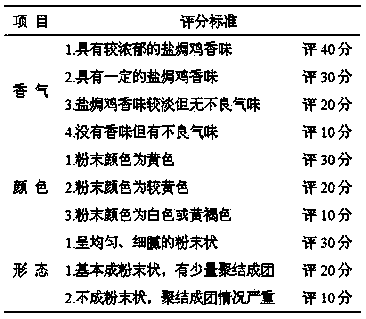Preparation method of salt roasted chicken flavor nutritional seasoning powder
A technology of nutritional seasoning powder and salt-baked chicken, applied in the field of food additives, can solve the problems of low added value, waste of resources, lack of effective recycling and the like, and achieve the effects of rich nutrition, stable ingredients and pure and thick natural bone flavor.
- Summary
- Abstract
- Description
- Claims
- Application Information
AI Technical Summary
Problems solved by technology
Method used
Image
Examples
Embodiment 1
[0043] S1. Pretreatment of raw materials: put the marinated salt-baked chicken bones and minced meat in an autoclave at 110°C for 25 minutes, and then crush them with a high-speed grinder to make meat and bone paste. The particle size of the meat and bone paste is 9.5mm.
[0044] S2. Adjust pH: Weigh 100g of meat and bone paste into a container, add deionized water to make the mass percentage of meat and bone paste to 12%, and adjust the pH to 5.5, (can be detected by Leici PHS-2F pH meter ).
[0045] S3. Enzymatic hydrolysis reaction: Add 0.5% compound flavor protease to the above container according to the mass percentage of the enzyme in the meat and bone paste, keep the temperature at 40°C, and enzymatic hydrolysis time for 2 hours.
[0046] S4. Enzyme inactivation treatment: the reaction system after enzymolysis was placed in a boiling water bath at 100° C. for enzymatic inactivation treatment for 6 minutes.
[0047] S5. Separation of enzymatic hydrolyzate: place the en...
Embodiment 2
[0057] S1. Raw material pretreatment: Put marinated salt-baked chicken bones and minced meat in an autoclave at 120°C for 25 minutes, and then crush them with a high-speed grinder to make meat and bone paste. The particle size of the meat and bone paste is 7.0mm.
[0058] S2. Adjust pH: Weigh 100 g of meat and bone paste into a container, add deionized water to make the mass percentage of meat and bone paste 20%, and adjust the pH to 6.0.
[0059] S3. Enzymolysis reaction: Add 1.0% compound flavor protease to the above container according to the mass percentage of enzyme in the meat and bone paste, keep the temperature at 45°C, and enzymolysis time for 3 hours.
[0060] S4. Enzyme inactivation treatment: the reaction system after enzymolysis was placed in a boiling water bath at 100° C. for enzymatic inactivation treatment for 6 minutes.
[0061] S5. Separation of enzymatic hydrolyzate: put the enzymatically deactivated enzymolyzate in a centrifuge, centrifuge at a speed of 4...
Embodiment 3
[0069] S1. Raw material pretreatment: put the marinated salt-baked chicken bones and minced meat in an autoclave at 125°C for 30 minutes, and then crush them with a high-speed grinder to make meat and bone paste. The particle size of the meat and bone paste is 5.2mm.
[0070] S2. Adjust pH: Weigh 100 g of meat and bone paste into a container, add deionized water to make the mass percentage of meat and bone paste 25%, and adjust the pH to 6.5.
[0071] S3. Enzymatic hydrolysis reaction: Add 1.5% compound flavor protease to the above container according to the mass percentage of the enzyme in the meat and bone slurry, keep the temperature at 50°C, and enzymatic hydrolysis time for 4 hours.
[0072] S4. Enzyme inactivation treatment: the reaction system after enzymolysis was placed in a boiling water bath at 100° C. for enzymatic inactivation treatment for 10 minutes.
[0073] S5. Separation of enzymolysis solution: put the enzymolysis solution after deactivation in a centrifuge...
PUM
 Login to View More
Login to View More Abstract
Description
Claims
Application Information
 Login to View More
Login to View More - R&D
- Intellectual Property
- Life Sciences
- Materials
- Tech Scout
- Unparalleled Data Quality
- Higher Quality Content
- 60% Fewer Hallucinations
Browse by: Latest US Patents, China's latest patents, Technical Efficacy Thesaurus, Application Domain, Technology Topic, Popular Technical Reports.
© 2025 PatSnap. All rights reserved.Legal|Privacy policy|Modern Slavery Act Transparency Statement|Sitemap|About US| Contact US: help@patsnap.com


